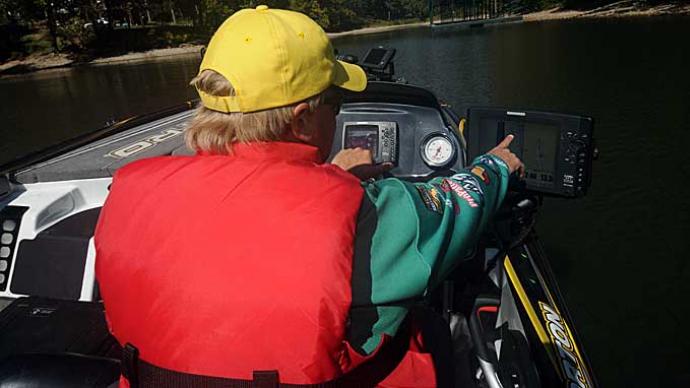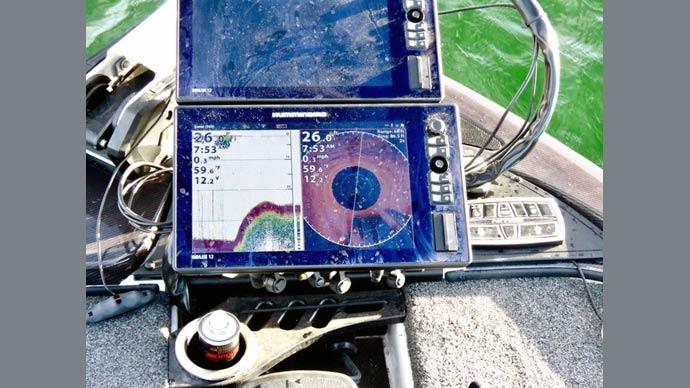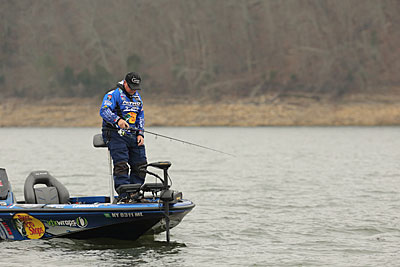
When Jamie Hartman launched his boat on eastern Tennessee’s Lake Cherokee in February 2017, he was entering a new world in more ways than one.
Hartman cut his bass fishing teeth in upstate New York, chasing largemouth and smallmouth on Lake Champlain, Oneida Lake, and the St. Lawrence River when they weren’t covered with ice. Those bass live in relatively shallow water that’s clear, making it easy, most days, to see where he needed to cast. Channel ledges, for example, were only something discussed in bass-fishing articles. It was the same situation for suspended bass, though that’s what he found on Cherokee, his first Bassmaster Elite Series tournament.
Smallmouth in the almost 30,000-acre reservoir were sheltering in their winter haunts, roaming open water in pursuit of schools of shad. Hartman couldn’t see them or the structure they were swimming around with his eyes, which were about 30 feet deep. So, he used his electronics, watching his small soft-plastic baitfish imitator, threaded on a 3/8-ounce Hart Attack jig of his design, dangle within the schools. His graph showed every bass that swam up to his lure, allowing him to call his shots.
When the scales closed at the end of the four-day tournament, Hartman’s 20 bass weighed 69 pounds and 3 ounces, good enough for second place. They also forced him to take a deeper look at the importance of electronics. “When I started the [2017] season, I had one [unit] on the dash and two little [9-inch screens] on the front,” he said. “I never thought I would need four graphs on a boat.”
Hartman found himself dedicating more time to scanning structure for schools of the tournament-winning bass as the season marched forward. “I needed another graph [on the console],” he said. And they needed to have larger screens — some used by his competitors resemble small TVs — to provide better and more views. But most importantly, he had to decide where and how to mount them so they could provide the most help.
Keep things consistent

Like rods and reels, lures, and your boat, electronics are another tool to help you catch more bass. They work best when their full potential is leveraged. Learning how to adjust them properly and interpret their information — Hartman found YouTube videos helpful at first — allows you to take advantage of every function.
Hartman, who relocated to Arkansas after his first Elite season, has always fished with Lowrance electronics. He said their menus are easy to navigate, keeping all their functions at his fingertips. That benefit was magnified when he mounted four identical units on the rig he ran during the 2018 season. “I used two 12s at the dash and two 12s up front,” he said. He never wasted time re-orienting himself to different units. Every button was in the same place, offering the same sized view.
Choosing the right electronics goes beyond screen size and model number. What capabilities — such as GPS mapping, down scan, side scan, and traditional 2-D sonar — do you need for your fishing? Do your units need to communicate with each other? How many can you mount on your boat, and where? That last question should be your first.
On the console
While all four of Hartman’s fish finders are identical, each is assigned a unique task. That includes the twin units he mounted at the console of his 21-foot Nitro bass boat.
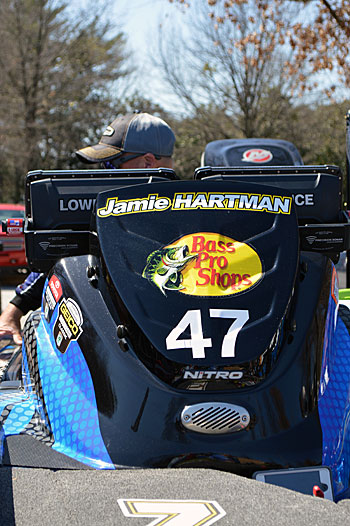
One unit is dedicated to structure and side scans, which Hartman monitors simultaneously by splitting its 12-inch screen. Hartman uses these views to find isolated pieces of structure and cover under and around his boat, along with the schools of bass swimming around them. “Having it on one side and structure [scan] on the other, you don’t have to flip screens,” he said. “That makes your fishing very efficient.”
Hartman doesn’t scan random parts of the lake. Limited practice time focuses his efforts on the specific spots he feels most likely to produce during the current season and conditions. To quickly find and stay on them, he dedicates half of the second unit’s screen to GPS mapping. The other half is for traditional 2-D sonar, which provides a quick and clear view of bottom topography and composition, along with the presence of baitfish and cover.
Hartman has a reason for using these functions on these units. They help eliminate unproductive water, and that process is most effective while he’s operating the outboard. He can idle across a flat, for example, and if his units don’t show anything of interest, he can hit the throttle and move to the next spot.
Adding two 12-inch fish finders to a boat’s console comes with considerations. Not only do they need to be in plain sight, but they also have to stay there while running, even in the roughest water. Hartman locks them down side by side above the steering wheel in a Precision Sonar mount. “It’s rock-solid,” he said. “When you put two big units on there, you have a lot of weight. Try to move them [while in the mount], and they won’t go anywhere.”
While a good view of your electronics is vital, you must also see where your boat is headed. Take time to find a placement that balances both. Move them if you constantly look around or over your units to see where you are running.
Mounting two units on the console directly in front of the driver may be the most popular option, but it’s not the only one. If there’s room for one unit to be in-dash, a second can be mounted to the console's right. Smaller units, for example, can be mounted to a handrail with a RAM mount. Some anglers put a second, or sometimes third, unit on the floor to the left of their feet.
Wherever your electronics end up, make sure they are accessible. They should be easily removed for safe keeping during storage or travel, so preserve access to the mounting nuts and the plugs for the transducer, power, and communication wires.
On the bow
Electronics are equally important when Hartman is fishing from his boat’s bow. He needs them in shallow water when, for example, he’s following the small ditches that largemouth use to move onto spawning flats in the spring or, as he did at Cherokee, keeping his lure on top of smallmouth schooling in deep water. He needs to see their displays at all times to be successful.
Hartman uses a stacker-style mount on his bow. “You look at the majority of [professional bass anglers], and that’s the deal because it’s so efficient,” he said. With one unit above the other, he can watch both at once, which is essential when considering the jobs he assigns.
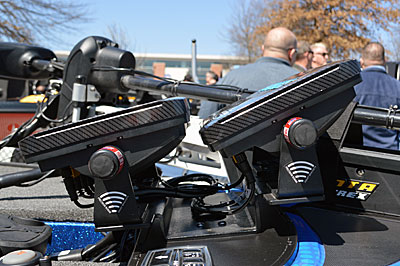
The top unit is dedicated to GPS mapping. “I like to have a big screen on the chart, and the zoom on a 12-inch [screen] is something else,” Hartman said. “It has a lot of precision to it.” Knowing where you are concerning the sweet spot on the off-shore structure is vital. It allows you to present your lure directly on it or experiment with retrieve angles in the case of crankbaits. Pulled in one direction, your deep-diver may generate a bite or two. But spin around and grind it across the same spot from a different direction, and you’ll load the boat.
Hartman chooses from three scenarios on the lower bow unit. He may dedicate it to traditional 2-D sonar or down scan, or he’ll split the screen between the two. Both functions help him uncover what’s attracting the bass in terms of cover and structure, but in different ways. Traditional 2-D sonar, for example, tells him bottom composition — hard or soft — and its contour. Down scan better defines the cover and the bass swimming within it. Deciding which to use is all about what he’s trying to accomplish at the moment.
Hartman could connect his structure scan transducer, which is mounted on his boat’s transom, to either bow unit. But he chooses not to do all his “looking” with that function from the console before making a cast.
Hartman mounts his units directly in front of his trolling motor’s pedal. Both transducers are placed on the trolling motor’s foot, providing a direct view of what’s below. “It’s accessible when I am fishing,” he said. “I do a lot of graphing, so I always look at that sonar, fishing straight down. It’s crystal clear when it’s sitting dead in front of you.”
A boat’s design determines where electronics can be mounted. While the trolling motor pedal is best in Hartman’s case forward, they are better placed to the right of the pedal in other brands. The key to finding the best spot is minding where other items are placed. Steer clear where the trolling motor is stowed, and rods are most often strapped down. And pay attention to where you usually stand while fishing. Do you like to fish as far forward as possible or next to the gunnel? If so, place your units so you can fish and still easily read all the essential information offered by your electronics.


